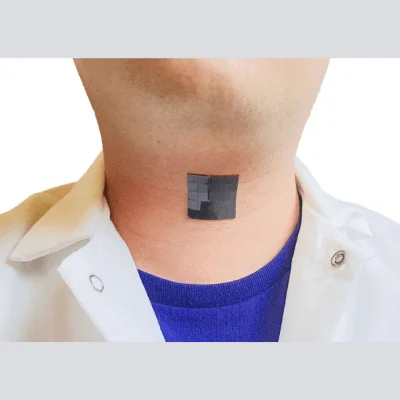A groundbreaking invention by a team of engineers at UCLA offers hope to individuals grappling with voice disorders, whether stemming from pathological vocal cord conditions or post-laryngeal cancer surgeries. Published in the journal Nature Communications, the innovation presents a soft, thin, and stretchy device, slightly larger than a square inch, designed to be affixed to the skin outside the throat, facilitating vocal function restoration with an astonishing 95% accuracy rate.
Addressing the prevalence of voice disorders: Current challenges and therapeutic approaches
Voice disorders affect individuals across all demographics, with nearly 30% of people experiencing such conditions in their lifetime. Current therapeutic approaches, including surgical interventions and voice therapy, often entail lengthy recovery periods, ranging from three months to a year, with some requiring extensive postoperative voice rest. Led by Jun Chen, an assistant professor of bioengineering at the UCLA Samueli School of Engineering, the bioelectric system is a culmination of prolonged efforts to aid individuals with disabilities. Notably, Chen's team previously developed a wearable glove capable of translating American Sign Language (ASL) into English speech in real time, facilitating communication for ASL users with non-signers. Comprising two main components, the device harnesses self-powered sensing technology and an actuation component. The former detects and converts muscle movement signals into electrical signals, subsequently translated into speech signals through a machine-learning algorithm. The latter component transforms these signals into audible speech, enabling users to express themselves effectively.
Engineering innovations in assistive devices for vocal restoration
Constructed with biocompatible silicone compound polydimethylsiloxane (PDMS) and magnetic induction layers, the device incorporates a soft magnetoelastic sensing mechanism capable of detecting changes in magnetic fields caused by laryngeal muscle movements. Remarkably compact, measuring 1.2 inches on each side and weighing approximately 7 grams with a thickness of 0.06 inches, the device adheres easily to the throat using double-sided biocompatible tape, ensuring comfort and reusability. In experimental trials involving eight healthy adults, the wearable device demonstrated exceptional accuracy. By collecting data on laryngeal muscle movement and utilizing machine learning, the researchers correlated signals to specific words, effectively reproducing them through the device's actuation component. Participants pronounced selected sentences both aloud and silently, with the system accurately amplifying their voice signals, reflecting the intended phrases with remarkable precision.
Breaking new ground: developing the potential towards
With an eye toward further advancements, the research team aims to expand the device's vocabulary through machine learning algorithms and conduct trials involving individuals with speech disorders. Noteworthy contributors to this research include UCLA Samueli graduate students Ziyuan Che, Chrystal Duan, Xiao Wan, Jing Xu, and Tianqi Zheng, all integral members of Chen's lab. Funding for the project was provided by various institutions, including the National Institutes of Health, the U.S. Office of Naval Research, and the American Heart Association, among others.
In a world where effective communication is fundamental to daily life, the development of this innovative device represents a beacon of hope for countless individuals grappling with voice disorders. As technology continues to advance, the potential for transformative solutions in healthcare grows, offering renewed possibilities for those in need.
Source: Nature Communications
Image Credit: UCLA






